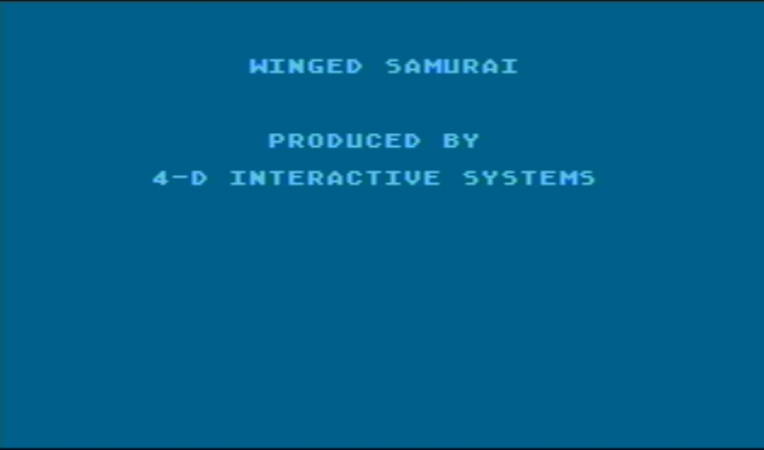

I am proud to be part of your squadron, men ! Your reputation precedes you ! Let’s give the Germans Hell !
The Germans ? Are you crazy, Chūi Narwhal ? We are fighting the Americans !
Ah ! Yes ! The Americans ! Of course. That’s what I said. Germans, Americans, all the same to me. Ready to defend, er, Tokyo I guess.
Rabaul !
Whatever needs defending, mkay ?

Well, to our planes, now !
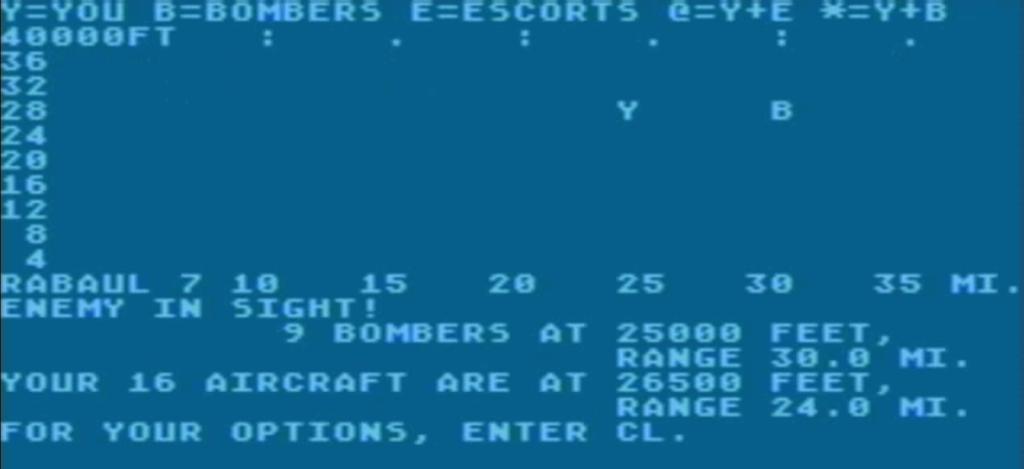

Well, it should be easy. The B25Bs have guns all around so I am not going to try to be subtle, though the front pass may be costly.

This was painful. Better luck next round ?

And done !

Commended by General Hyakutake in person for THAT small thing ? Well, I don’t deserve it but thank you. The whole affair took 50 seconds, really :
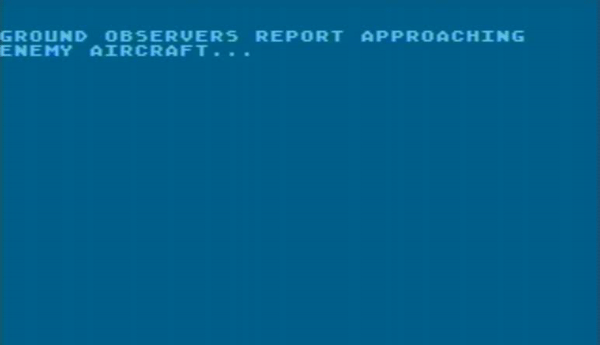
Time for next mission then. It looks like the Americans still want to destroy Rabaul.
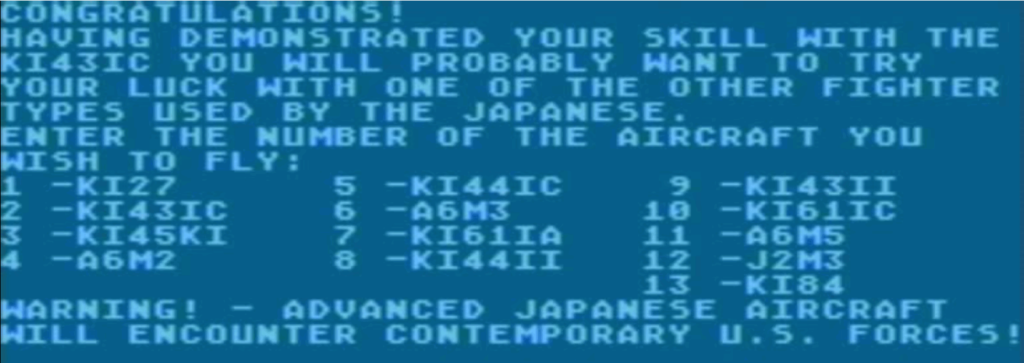
Well, I am flattered to be offered the choice, though I am not sure moving from the KI43 to the KI27 would be much of an upgrade.
Let’s take A6M5, an advanced iteration of the Zero.
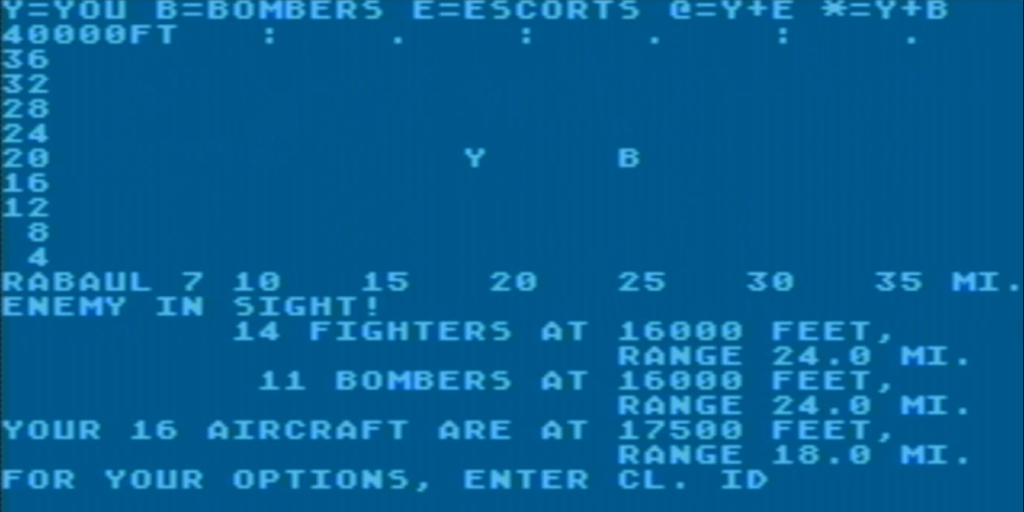

I am fighting against a significant escort this time. We know the F4F-4 (the Wildcats) and the SBD3 (the Dauntless – a dive bomber) from Midway Campaign. Here is what the manual says about the F4F :

If the F4F were “nearly a match”, this means that if I challenge the Wildcats I will not be left with enough planes to defeat the Dauntless. But “poor rates of climb” you say ?
Maybe that’s where the solution is : Dive, get them to follow, climb back.
And so there was much diving :
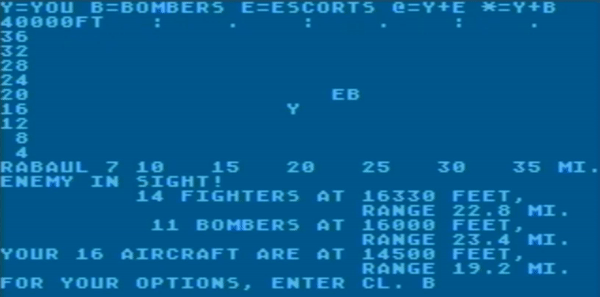
And then there was much climbing :
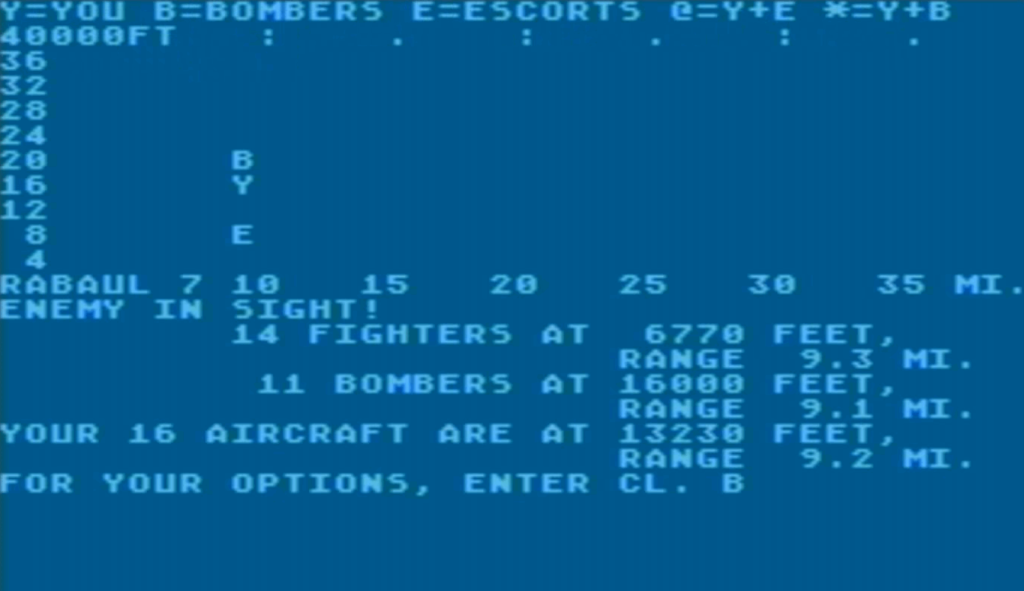
Well, apparently I climbed twice as fast as the escorts, so I have some time to take care of the bombers. I am actually given several options :

“Firing pass and climb” would put me “above” the Dauntless. From what I understand, defense fire takes action after your movement, so it would not be good for me (the Dauntless have a rear-machine gun that can shoot upward) so I am going with the boring “Dogfight” :

No more bombers to threaten Rabaul. And guess what I received for my acheivement ?

Yes sir, another Commendation from the man !
And tomorrow, I will wake up for another Rabaul Day !
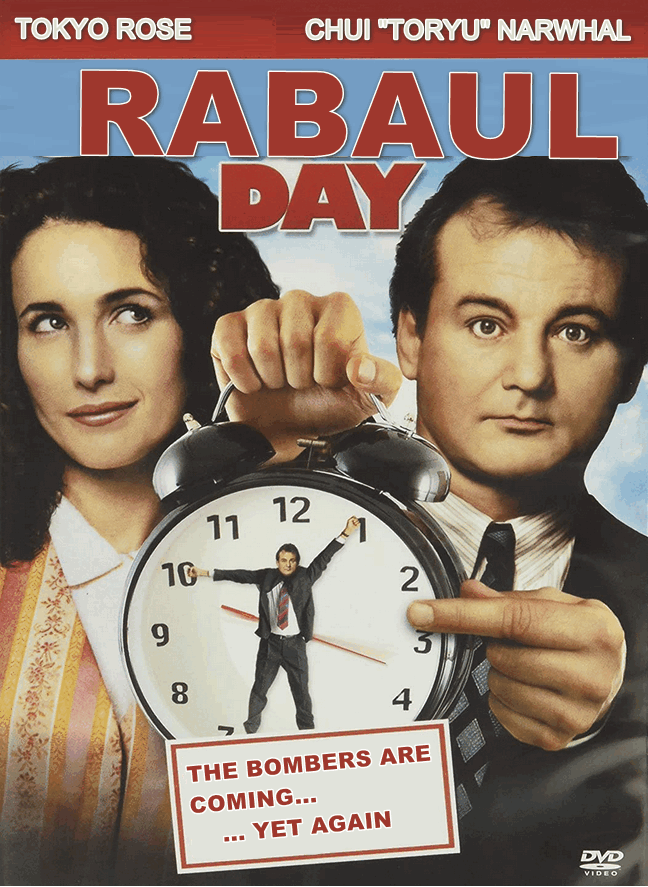
Rating & Review
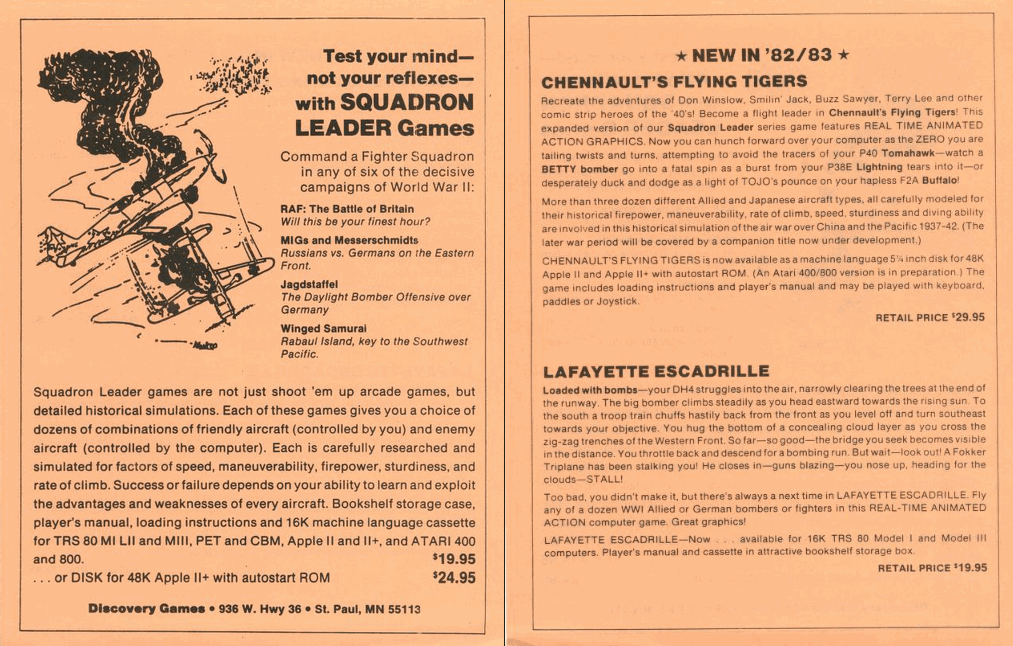
The Squadron Leader games by David A. Wesely, USA
First release :
RAF, M&M, Jagdstaffel and Winged Samurai : 1980 on TRS-80
Chennault’s Flying Tigers : Probably March 1983 on Apple II
Tested on : Atari emulator
Total Hours Tested : 2
Average duration of a campaign: 3 minutes, except Chennault’s Flying Tigers : 30 minutes
Difficulty: Trivial (0/5)
Would recommend to a modern player : No
Would recommend to a designer : No
Final Rating: 7/100
Squadron Leader is the brand name given to a series of 6 games of which 5 were designed by David A. Wesely and published by 4D Discovery Games.
David A. Wesely is famous for rediscovering Strategos and for being one of the precursors of role-playing games “before Gary Gygax” with the Braunstein games. The Squadron Leader games are part of his stint with computer games – he would also be credited in Avalon Hill’s 1982 “Guns of Fort Defiance” and on various ports from his time at Coleco. By the second half of the 80s though, he seems to have mostly retired from the gaming industry, computer or not.
The first four Squadron Leader games are a carbon-copy of one another, with only the context and stats of the planes changing :
- Winged Samurai (1980), in which the player must defend Rabaul from Anglo-American Bombers,
- RAF: The Battle of Britain (1980), in which the player must defend London from German bombers,
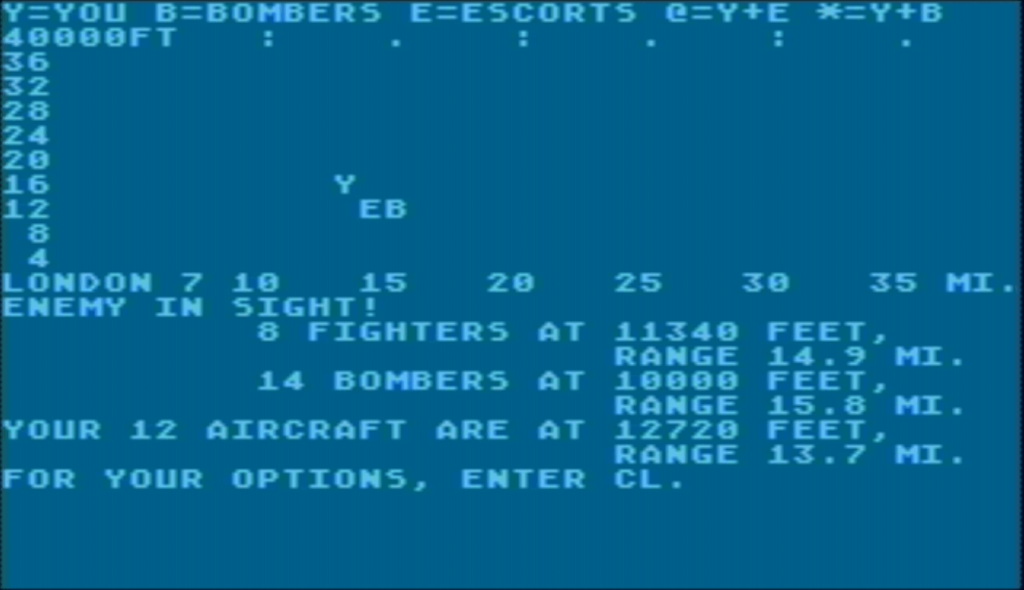
- Jagdstaffel (1980), in which the player must defend “Zielhafen” (=”port”) from Anglo-American bombers,
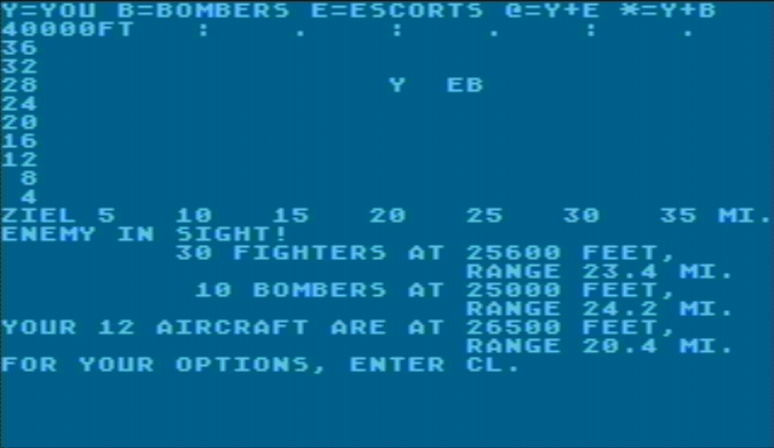
- MIGs and Messerschmidts (1980), in which the player must defend Leningrad from German and Finnish bombers – note that I could not find this one, only a description of it.
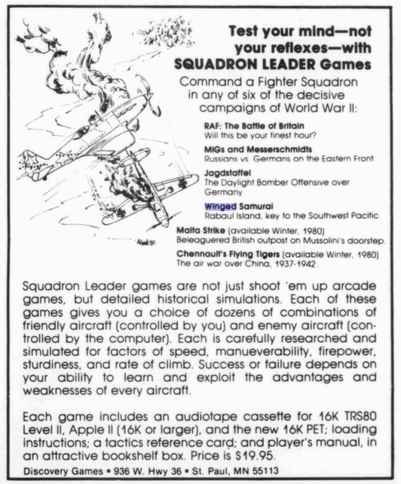
- The 5th game is Chennault’s Flying Tiger (1982) (“in which the player must defend Kunming from Japanese Bombers“), which looks, quacks and walks like the four previous ones…

… but actually it becomes real-time combat when you get into combat range !

- The last one is “Lafayette Escadrille“, a 1983 TRS-80 only game where surprisingly you do not defend Verdun against German bombers in side-view, but rather do various missions in top-view. The game seems unrelated to David A. Wesely.
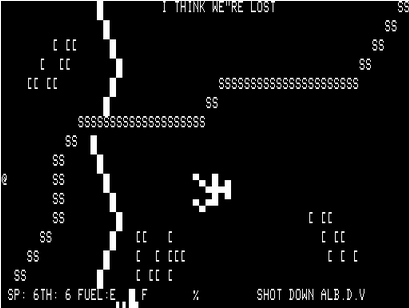
My review will only cover the first 5 games.
A. Settings & Aesthetics
In terms of settings, despite having all the correct names for the planes, the games are not immersive. It is too simplified, too “puzzly” to feel like air combat.
The planes behave differently in game, but as the enemy also scales to your level it all plays more or less the same (the key difference being whether your planes can climb faster than the AI’s planes – if not, you are in trouble). Playing the Me262s in Jagdstaffel, usually facing P-51, is barely different from playing Zeroes against Wildcats.
On the other hand, the manuals are really well-done, with nice short descriptions of the planes :
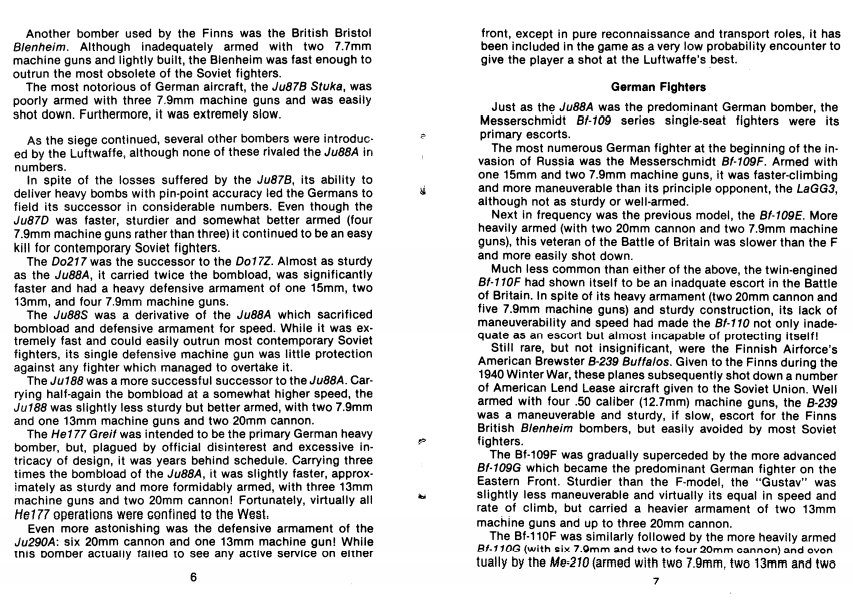
As for graphics, well, no such thing in the four 1980 games, and some wireframe graphics in Flying Tigers
Score : 2/20 with the bonus point. 3/10 for Flying Tigers due to graphics existing (barely).
B. UI , Clarity of rules and outcomes
Well, UI is clear enough. On the other hand, outcomes are not. How many bombers will you shoot down with your Spitfires ? Why did you lose so many Spitfires ? Which distance will you travel ? You have no idea.
If there had been some specs for the planes, even something as abstract as an “attack value”, the game would have been much better.
There is also an issue when your planes are directly above or below the enemy bombers. Telling them to fly toward the bombers may actually move them away from the bombers.
Score : 2/20
C. Systems
I believe the AAR explains the system well enough. You control a wing of planes that must intercept a wing of bombers before they reach the left of the screen – not one bomber must go through. You only control whether you go toward or away from the bombers/fighters, and whether you climb or dive.
They are different ways to attack the bombers (diving attack, climbing attack, …), though it does not change much in my experience and for instance found out that diving attacks are not limiting losses that significantly even against planes with only rear-gunners, and can put you so out of position that you often cannot finish off all bombers before they reach their targets.
After a tutorial scenario, the game will give you a “name” that will allow you to choose your planes for the next battle. There is only one “name” for all the 1980 games, at least two for Flying Tigers.
Flying Tigers is special in that if you choose to “dogfight”, then you get to fight in real-time :
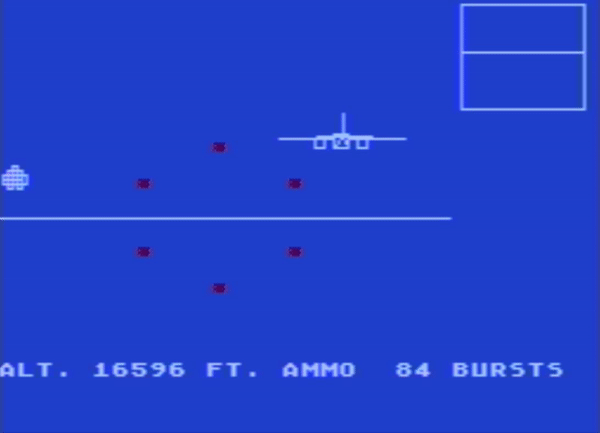
I am not the Plane Simulation Scribe so I did not test it extensively – yet from my tests this action phase has a lot of issues :
- You cannot point the nose up much when the target is above you,
- If the target is below you and you point the nose down to aim at it, the game can eject you from action phase telling you that you “dived out of combat“.
- You only fight one plane at a time,
- The game sometimes “jumps” to another plane (not sure if it is another plane in your team or another target), without transition, so from your point of view your target teleports on your screen,
- Boy is it mind-crushingly boring. The GIF above lasts 1 minute, I needed another one to finish off that bomber – and now imagine that you typically have 6 – 7 bombers to shoot down !
But the worst is that the action phase makes the rest of the game irrelevant. The game expects you to outperform during dogfight, so it gives you only 4 planes in a scenario, a number that makes diving attacks and other “tactical” moves inefficient. Moreover, in my experience at least, the enemy fighters in the tactical phase always climb faster than you in Flying Tigers, so you will have to go through them no matter what. Given this, you can just as well fly the most direct route to the enemy bombers and dogfight them directly.
Score : 2/20 – 1/20 for Flying Tigers.
D. Scenario design & Balancing
There are 5 types of scenarios :
- The bombers don’t have any escort. You can pretty much fly the most direct route to the bombers and dogfight them until there are no more bombers. Trivial.
- Escort made up of planes which have lower climbing speed than your planes. Dive way below the bombers, let the escort follow you, then climb up and shoot down the bombers. Easy.
- Escort made up of planes which have same / better climbing speed than your planes, but are slower – go to the left or to the right of the screen, bringing the escort with you, then double-back, pray that the escort does not shoot down too many of your planes when you go “through” them, then get to the bombers.
- Escort made up of planes which are better than your planes in every way but are less numerous – you can hope to dogfight them, and hope to have enough planes left to also shoot down the bombers.
- Escort made up of planes which are better than your planes in every way and more numerous. Just type NG for “New Game”.
The latter “unbeatable” scenario is relatively common, in particular in Jagdstaffel (which, granted, is realistic).
As for Flying Tigers : whatever the scenario, the best strategy is to beeline for the bombers.
Score : 1/20
E. “Fun” and Replayability
These games were boring from my very first attempt, so same score as my plane: Zero
Score : 0/20
Final rating :
7/20, including 1 or 2 points for the manuals. Don’t play these games, read their manuals
Contemporary reviews
The games largely went under radar, so Squadron Leader only collected a handful of reviews. Most were short and purely descriptive, yet most fell for the trap of saying something like “the program accurately reflects the characteristics of the planes” (Creative Computer, December 1980 for Jagdstaffel), to which I want to answer: “The manual certainly, but the game how do you know ?”. Space Gamer even states about Winged Samurai that “in creating this historical authenticity, the programmer sacrificed the game to the simulation.” I feel I have neither.
As for Chennault’s Flying Tigers, the only review I could find is in Computer Gaming World 3.6 (December 1983) – the reviewer confesses that he was attracted to the game by the promise of the action phase, but then his comments make clear that it did not deliver, unlike the approach phase that he seemed to have quite liked. He concludes : “I can’t figure whether the game is a splendid failure or a flawed success”.
All Squadron Leader games would make it to Computer Gaming World‘s list of computer wargames in 1991, where I am finally vindicated. For Flying Tigers : “wire-frame graphics, lack of realism and limited play value are sufficient to deter anyone from further play.”
10 Comments
Small note there : I wanted to R&R Computer Air Combat but it was longer than expected (I wanted to compare if indeed different planes have different performance depending on say altitude) so CAC will be Thursday instead and today I covered the Squadron Leader games instead.
Since they are a bit disappointing as wargames, I will probably try to fit Galactic Trader before Thursday as well.
Ouch. Is the lowest score that a game has gotten yet?
Yes, though I suspect it can be beaten.
I look forward to see what game that will be!
This game looked mostly inoffensive (except for the dogfights, those seemed a pain), at least compared to Midway Campaign, just completely uninspiring. Bravo for enduring through it.
Th e defense of Rabaul…what a cool theme for a game. Playing as the Japanese! And you get a choice of so many aircraft. Say what you will about the game, at least it’s not another Battle of the Bulge clone.
I think to understand this era you had to have played games like SPI’s Air War. The designers certainly had, and these computer games were their progeny.
It is pretty certain that David Wesely, being a wargamer, had played Air War or some other similar games (by the way – I added Air War to my non-exhaustive list in my Computer Air Combat Intro, I had missed it for some reason). The game is supposed to be based on his self-published 1969 “Bombers & Battleships”, though I could not find this game anywhere, even on boardgamegeek. The lineage between Air War and other similar tabletop and Computer Air Combat is way more obvious.
Just a little pointless trivia… the first game in the series – R.A.F. Battle of Britain – the title screen shows the credit:
Game developed by David L. Arneson.
Programmed by Stephen Goss
Based on the Bombers & Battleships game by Weseley and Maker.
I don’t have the manual for R.A.F. but the manuals for the later games don’t mention Arneson at all, only Weseley as developer, Goss as programmer.
Arneson was, of course, the co-creator with Gary Gygax of Dungeons & Dragons.
You’ve got a good attention to detail, I had not noticed.
Possibly, Weseley just swapped some planes in the later iterations, keeping the code intact and thought “Well, I did THIS game alone” :).
Or Arneson did not want to be associated to the milking of the design.
As for your other comment, you are right – I can’t think of any other game turn-by-turn with a side view. I think the design could have been expanded upon to an extent (with fuel, ammo, planes separated in smaller wings, more interesting missions, …).
One last observation of this one… With all the 2D representations of air combat wargames on the computer, this appears to be the first and only one I know of that puts the spotlight on altitude, using the side view rather than the top down. Shame about the ‘game’ but it’s at least one thing I think they got right. Are there any other computer air games that use this view… outside of the action games like Sopwith and Defender, I mean?
A short article [in Russian] covering this forgotten series:
https://www.old-games.ru/forum/blogs/vozdushnye-srazhenija-iz-vosmidesjatyx.6042/
I found the article interesting because the author reckons that, due to the different characteristics of the planes/air forces in the covered eras, the games in the series play somewhat differently; thus he gives Discovery Games a little more credit than I did myself.